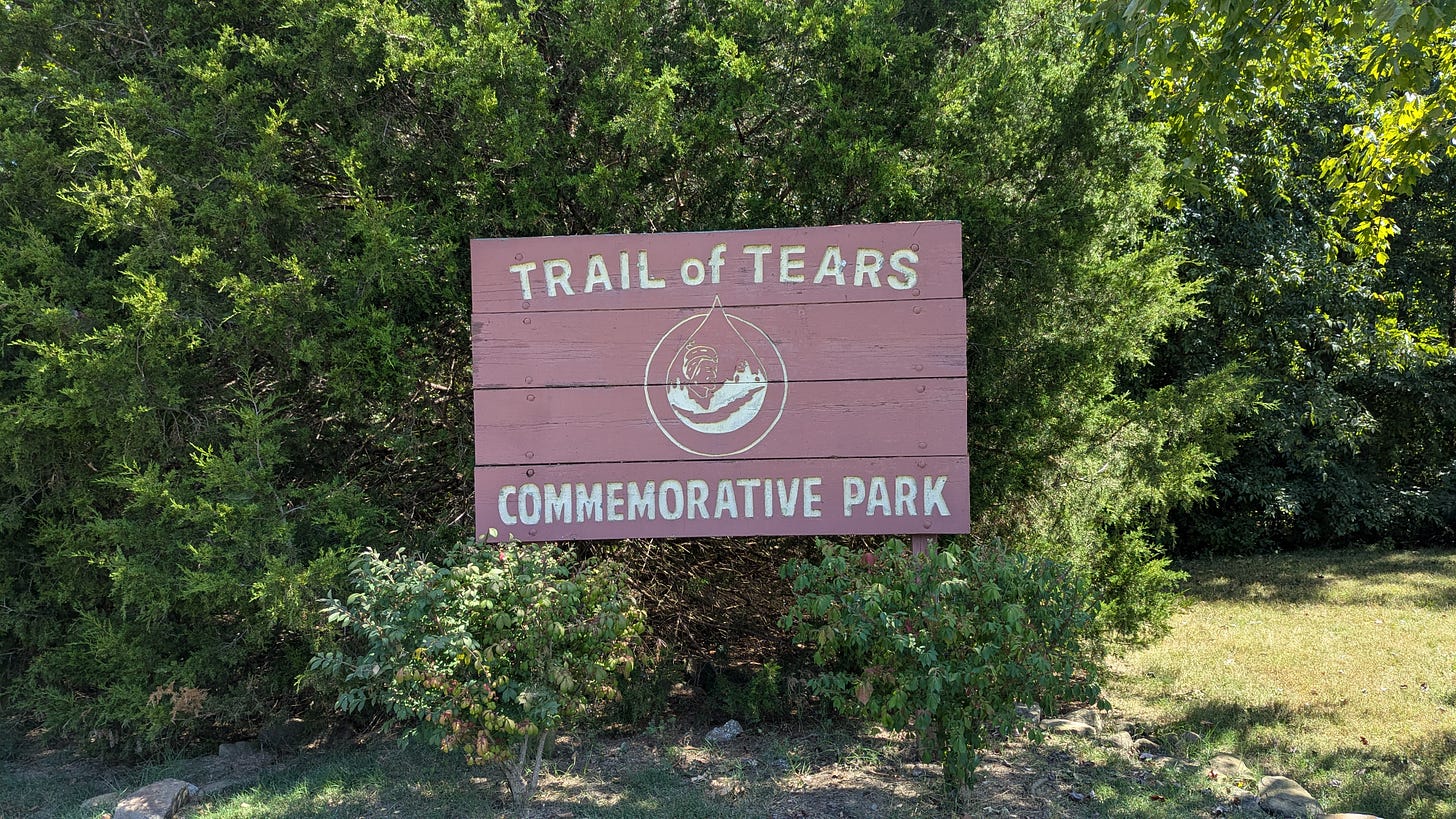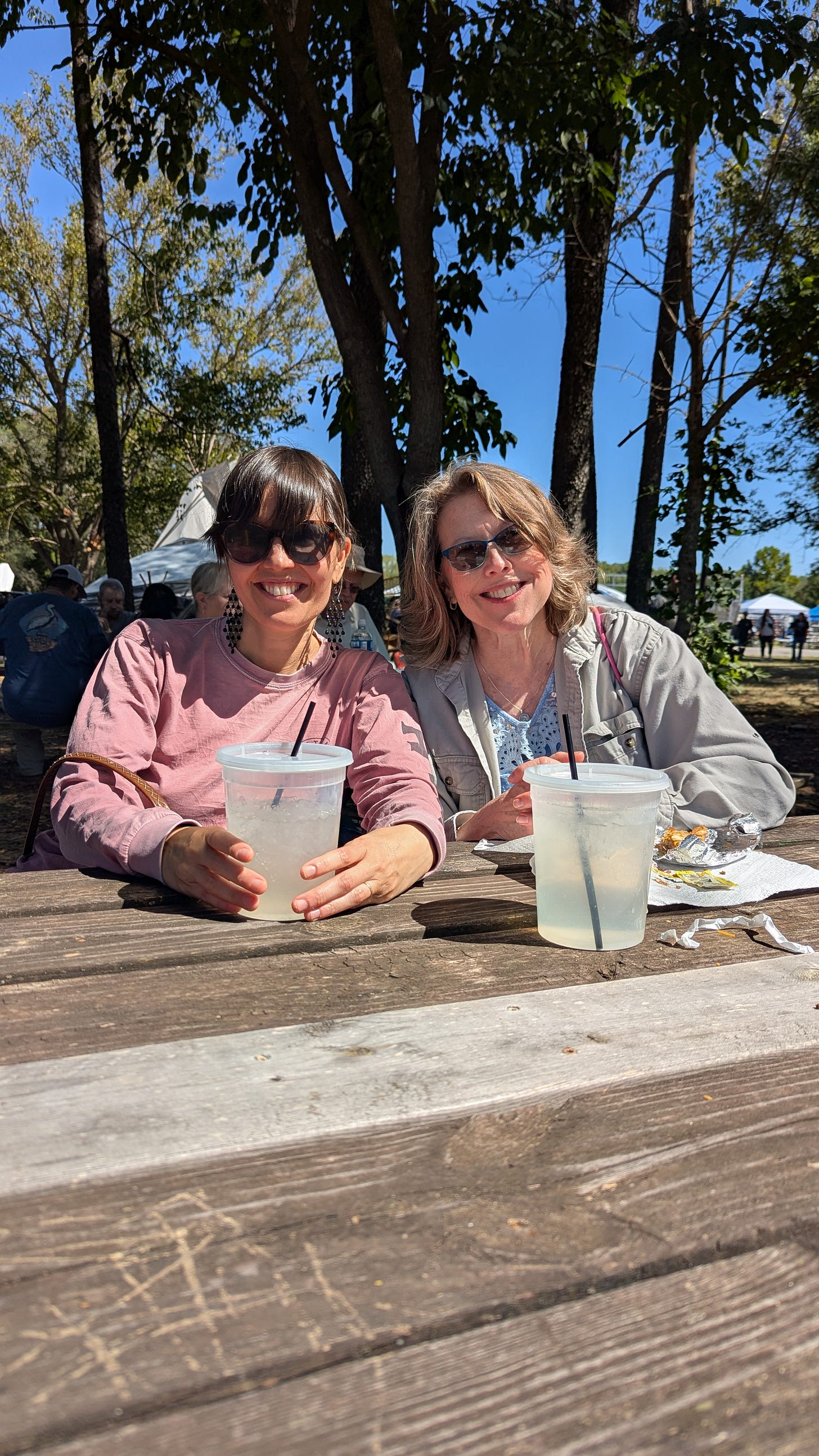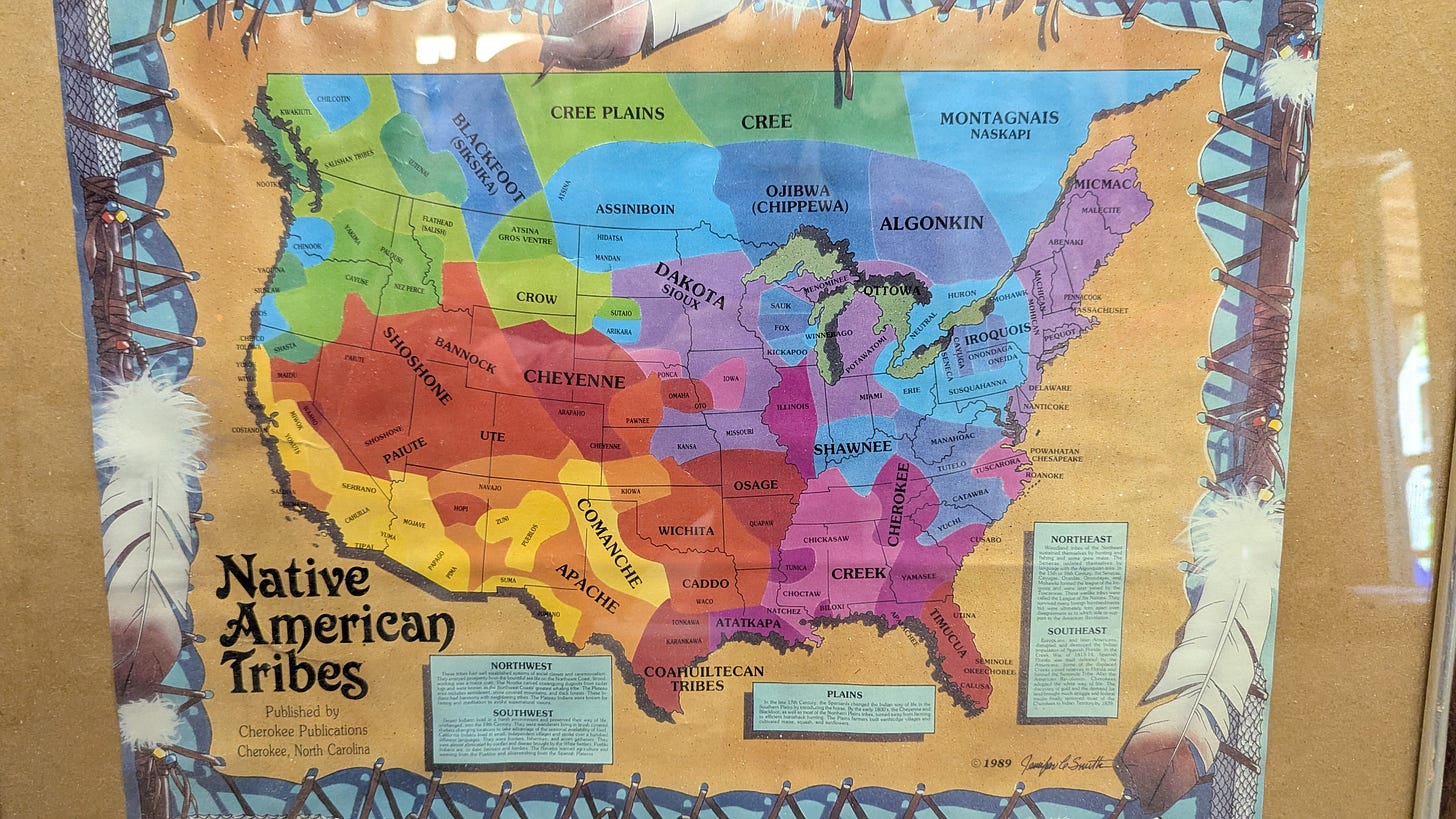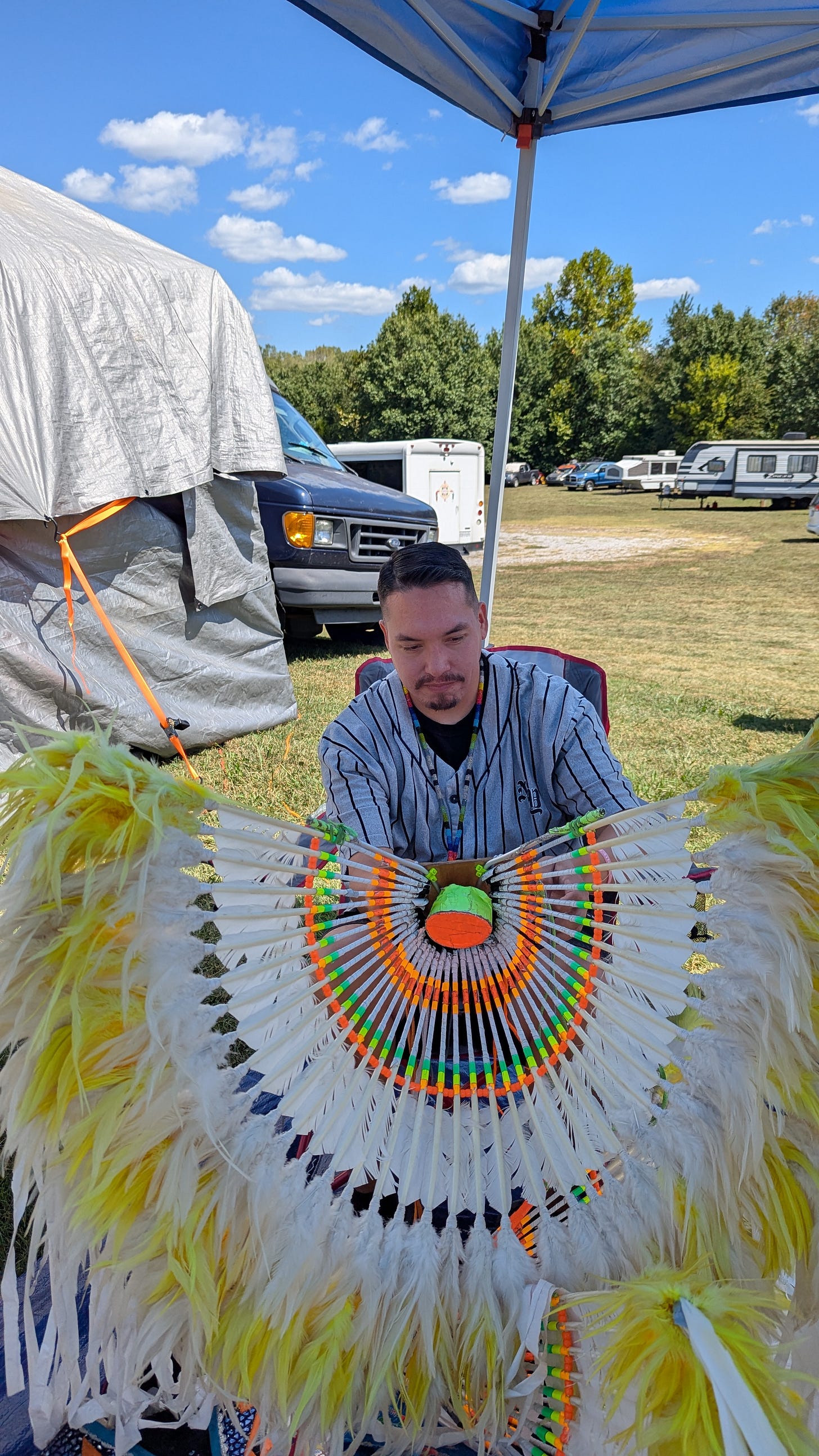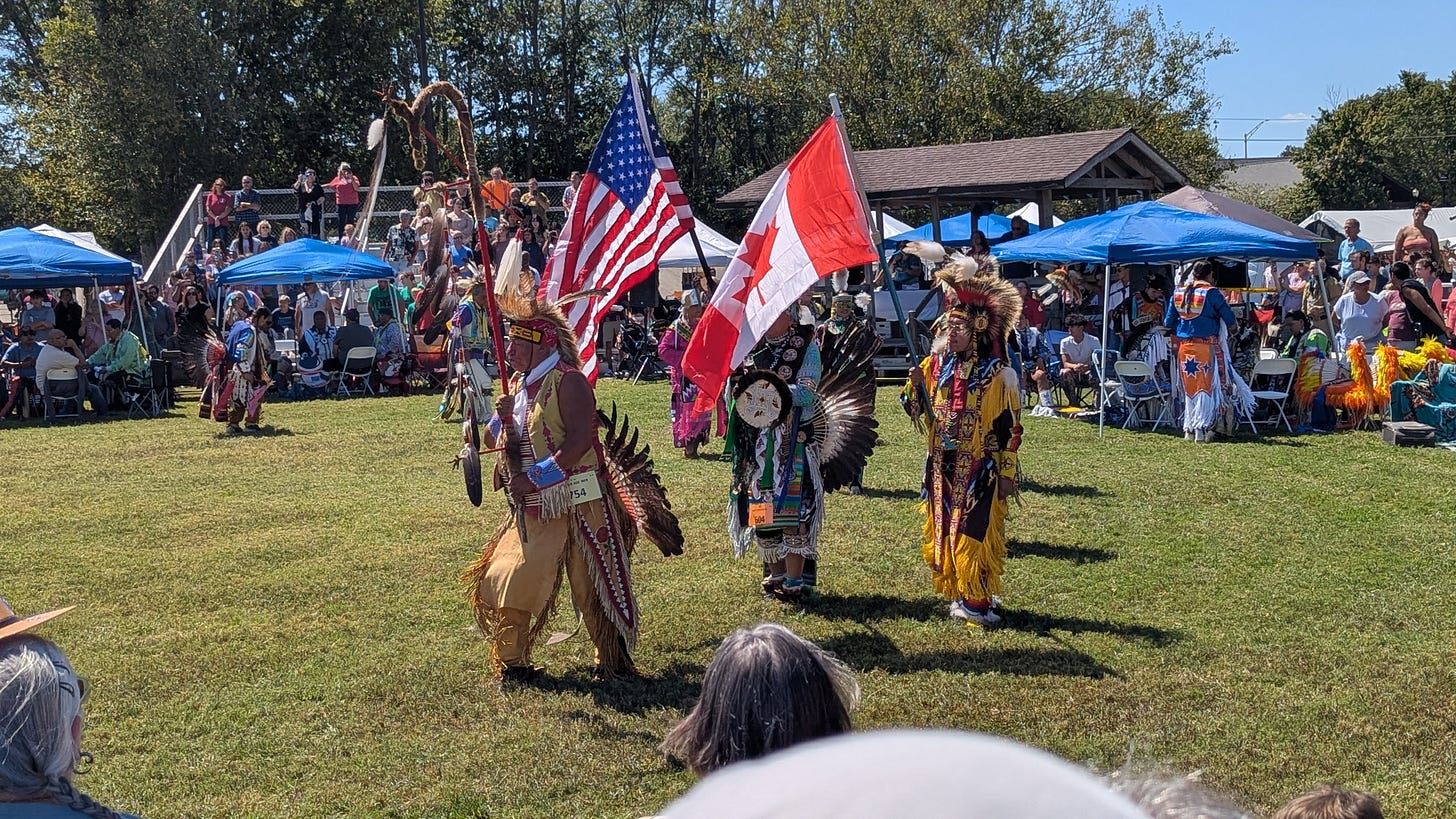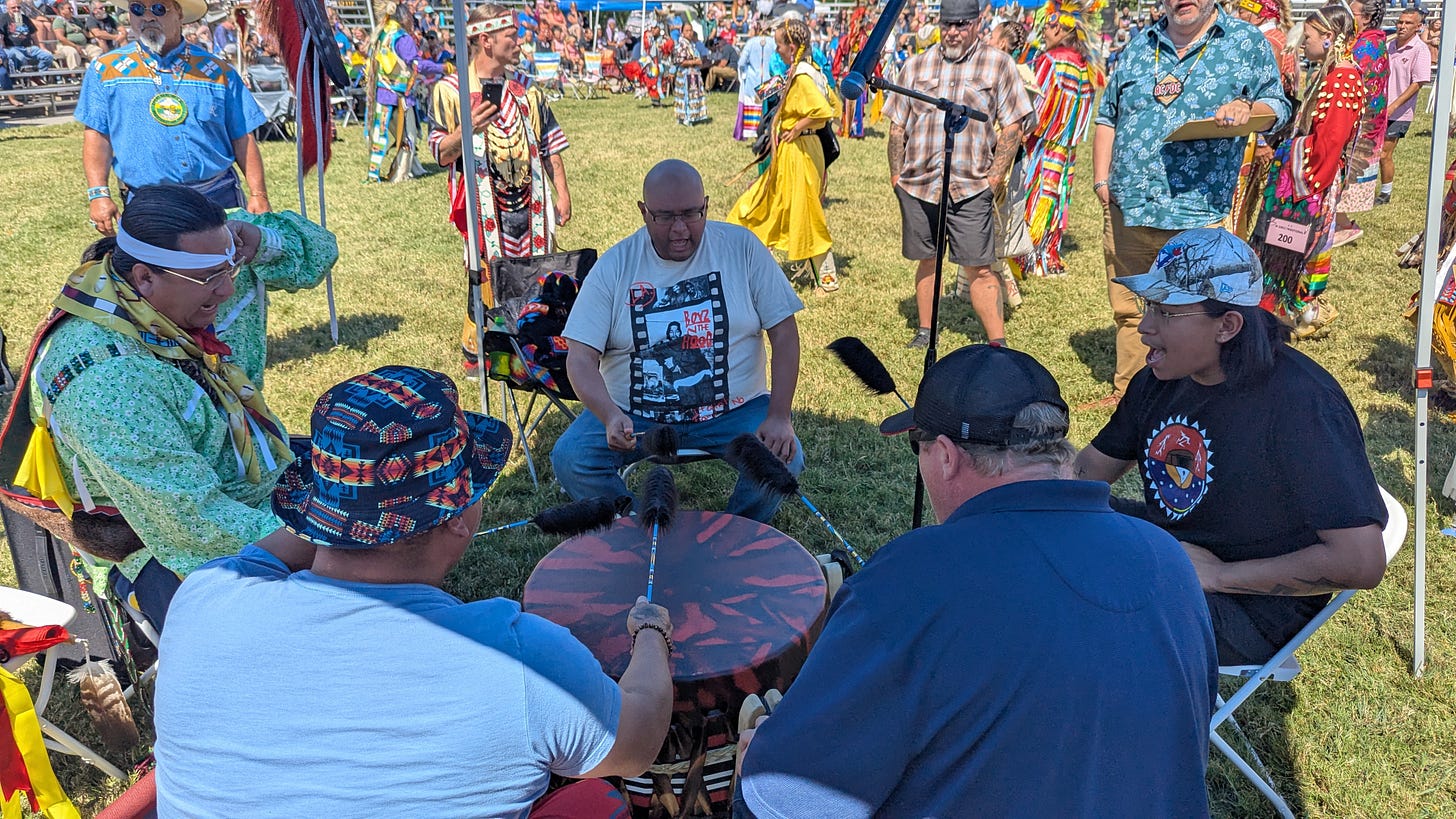Visiting The Trail of Tears Pow Wow in Hopkinsville, Kentucky
"The Trail Where They Cried"
I froze when I read the name of the 38th annual “Trail of Tears” Pow Wow, happening in Hopkinsville, Kentucky. I don’t know what I expected it to be called, but from the scant knowledge I have about Native American history, it didn’t sit right. I learned a lot a few years ago when I travelled out West to Monument Valley and passed through some reservation towns. I felt even more educated last year when I consumed Sherman Alexie’s beautiful young adult novel, The Absolutely True Diary of a Part-Time Indian. Everything I know about the Trail of Tears is bad. Basically: the US Government forces Native Americans to leave their land and take a long and deadly journey West.
Something about that title did not sit well with me as the setting for a celebration of Native American culture.
But what do I know?
I approached yesterday’s Pow Wow with an open mind. I went along with my Aunt Lisa, who has gone to them for years. She loves going and I have wanted to go with her for a long time. Yesterday we made it happen.
I didn’t do much research before, but I talked to Aunt Lisa and I read a few comments on the Pow Wow Facebook page to learn about Pow Wow etiquette. You should never refer to the regalia as a costume, you are not to pick up feathers that are dropped on the ground and you are to ask to take photos of individuals when they are not performing.
On Sunday morning around 9am the Morrises hit the road, driving behind the Parsons (my Aunt and Uncle). We headed to Hopkinsville, with no idea what awaited us. We drove through big empty highways, with corn and soybean fields on either side. We pulled into the Trail of Tears Commemorative Park and paid our $10 to look around. Everyone was just beginning to set up.
It was around 10am when we arrived. My brother Zach and I decided it was time to try some tasty “frybread.” He got an “NDN” Taco which was kinda like a taco on fried bread, and I got peaches on my bread. It was enormous. I can confirm I did not need all of this, especially after I washed it down with a gallon of lemonade.
We were fed for the day. We browsed jewelry and I took photos of interesting t-shirts. We walked around the park itself and I’m so glad we did, as I spoke to a lovely volunteer named Richard who gave me some great context for why the Pow Wow is called what it is. He spoke to me in more depth about the Trail of Tears, how American Indians were given two years to leave their homes. Some members of the tribes signed treaties, although the validity of the treaty is still questioned. This park is called the Trail of Tears because it represents one of the spots that they stopped along the way to what is now Oklahoma. They often travelled by horse and cart and many died of starvation, frostbite and disease.
The website says:
”This historic park is one of the few documented sites of the actual trail and campsites used during the forced removal of the Cherokee people to "Indian Territory". It was used as an encampment in 1838 and 1839. This park is the burial site for two Cherokee Chiefs who died during the removal - Fly Smith and Whitepath. This long, cruel relocation has become known as the "Trail Of Tears" and by Native Americans as "The Trail Where They Cried".
Here’s a great “nutshell” video from PBS for more details. Andrew Jackson, what an asshole! So much of this history is murky in my head; I had no idea for example that the Native Americans sided with the British during the American Revolution, which of course did them no favors when the British lost.
When I understood that the name of the Pow Wow was only called what it was because of the significance of the park, it made more sense.
Richard showed me the first Cherokee Syllabary and also the Cherokee Phoenix newspaper that was created in the 1820s and printed in both English and Cherokee. I particularly love seeing the map of American tribes. The fact that I know the traditional land names in far more of Australia than I do in the US is telling about the two countries' priorities in terms of education. (Though maybe things have changed in America since I grew up.)
My Mom and Aunt Lisa walked around in the little museum in the park for a bit and then returned to the main grounds just as the music was starting. I spoke to a man named Marcus who was putting together his headdress to dance later. He was 36 and from the Northern Arapaho tribe in Wyoming, but he now lives in Wisconsin. He travels through the US and Canada, dancing competitively. He quit his full time job to do this, and he referred to his outfit as “men’s fancy.” If you want to follow Marcus’ journey you can find him on Instagram.
Shortly thereafter we entered the arena as we were beginning to hear the drums and the singing.
People sat on bleachers while an MC told us we needed to learn the history about Native America before “Trump shuts this place down.”
He also mentioned that Trump has a picture of Andrew Jackson in his office, which tells you all you need to know. Apparently Jackson once said: “Elect me as president and I will get rid of each Indian.” (Thankfully he failed at this mission.)
“Native people don't identify or have respect for the government,” the MC told us. ”It was not by design that we are here, but it didn’t happen. The battle continues now, not with guns but in the courtrooms.”
He also mentioned that public schools did an atrocious job telling the Native people’s histories, which, clearly I can confirm.
He mentioned the nearby Mantle Rock in Livingston County Kentucky where more than 10,000 Cherokee passed through and where hundreds died.
We were asked to stand respectfully to welcome the dancers and the men were asked to take off their hats. Then we watched as a variety of tribes with a variety of dress and dance entered the circle. The sun was intense, but it was worth it to see the different ways people moved and the bright colours of their feathers and to hear the bells around their feet jingle.
While yes my knowledge about America’s indigenous history is limited, I’ve observed plenty of pop culture references in my life (many I’m sure which are politically incorrect/offensive). After growing up watching movies and reading books around American Indian culture, it was really cool to watch something happen that was actually organised and implemented by Native Americans.
Two men held giant Canadian and American flags to recognize tribes from both countries. The flags didn’t bother me, but it was intriguing to me to see the American flag so appreciated, especially given the history we’d just been learning about.
The MC invited a woman forward to say a prayer and talk to the great creator on our behalf.
Then they sang the traditional national anthem. The drums and the singing were incredible to listen to. They had different tents set up where different groups collectively banged a drum and sang out in different pitches; it almost sounded like a scream or a war cry yet also like a song. I walked around to get a closer look. At the tent where I watched, it was only men singing in the circle, but young women behind him joined in the song. I believe they were the same women I spoke with when I ordered my fry bread.
They sang the traditional national anthem and then they invited veterans and their family into the arena.
“Let’s welcome veterans, our warriors into the arenas, not a lot of cultures do this, but we do,” the speaker said.
I watched as veterans and their families, Americans of every skin color and age entered the circle.
Conversations and presentations around war give me mixed feelings. I think of myself as a proud pacifist. Aggressively, controversially neutral in almost all situations. Live and let live and encourage everyone else to stop being violent too. Somebody has to put down the weapons first. As long as I’ve been able to think, I have struggled with the US’ relationship with the world and war. I get nervous at any activity that seems to glorify war, yet I did feel teary eyed watching the circle fill with people, why exactly, I’m not sure. Both my grandfathers were war veterans, and many times in my life while in America I have looked people in the eye and told them “thank you for your service.” The phrase “warrior” and “veteran” sit in very different parts of my brain. I prefer the word warrior.
Even if I’m a pacifist, that doesn’t mean I can’t be grateful and honor warriors across the world who had fierceness within them that made them able to fight, even though many of them I’m sure didn’t have a choice and were drafted.
The speaker went on to discuss code talkers or “wind talkers” in WWI and WWII who used Native language from 24 tribes to help the US win both wars. Their languages were used as secret communication on battlefields.
He invited fluent speakers to come forward and be honored. Only ten people gathered, all of whom (I presume) spoke different Native languages.
"We are losing this language, folks," the MC told us.
I watched a man named Mu Roberts do a dance with several small hoops. Mesmerized, I considered how I have been hula hooping for probably more than half my life and have never thought about where the origins of the movement came from beyond hippies and carnies. Mu had moves that I could only dream of. The hoops were smaller than the ones I tend to use. He made them into shapes around his body.
The dances went on all afternoon, and I got up to look at crafts and also to see if anyone else would speak with me. I had a great interview with Niles Aseret. He and his wife sold me some beautiful earrings shaped like colorful corn cobs! You can listen to our entire five minute interview if you click play on the photo below, and I’ll also highlight some of the details.
Both Niles (Nez) and his wife Jean are originally from the Navajo Reservations in Arizona, but they moved to Tennessee in 1983 because they didn’t have running water. They still speak Navajo fluently and will speak it to each other occasionally. His relatives on the reservations still speak it and there is also a radio station there where they speak it. He created bumper stickers not too long ago to bring awareness to the code talkers, the same thing the speaker at the Pow Wow had mentioned.
”A lot of people in our country don't know about the code talkers,” Niles said. “if it wasn't for them, our society wouldn't be as it is today. Matter of fact, this would probably be governed by the Japanese or the Germans. And the code talkers are the ones that saved our freedom and flag. That's the reason why the flag is still flying and our freedom is still here too. So that's why the code talkers are very important to our society.”
He told me how the Navajo have a holiday if they live on their reservations, but for him, that’s not good enough.
“What I really was anticipating to get is a national holiday for all of them. They deserve that holiday. If Martin Luther King can have one, they should have one. And our president and the past president should be well aware of what the Native did for this country. It's very sad that they haven't given them a national holiday, which they deserve that big time,” he said.
Niles himself is a Vietnam Veteran. I, of course, thanked him for his service. If you would like to learn more about their business, Nez B’s Indian Jewelry, which I can confirm is gorgeous, you can reach them at (615) 796-8478.
Shortly thereafter we all headed home, commenting on the big interesting fun day we’d had. Thinking about life and land, I again looked out the window at the empty highways, the soybeans and the cornfields all around me.
Readers, if you made it to the end, this is just the beginning of Alex’s journey to understanding America. Every time I return home I experience a relearning, seeing new things through my old eyes.
I am grateful to the folks at The Trail of Tears Pow Wow for sharing their history, their culture and their knowledge with me. I hope this Substack did the day justice. I would encourage anyone in the US reading this to further explore Pow Wows in your area.

